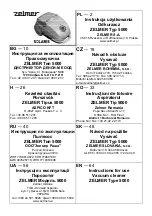
WARNING:
When servicing, use only identical replacement parts. Use of
any other parts may create a hazard or cause product dam-
age.
WARNING:
Always wear eye protection with side shields marked to comply
with ANSI Z87.1. Failure to do so could result in objects being
thrown into your eyes, resulting in possible serious injury.
WARNING:
Before inspecting, cleaning or servicing the machine, shut off
engine, wait for all moving parts to stop, disconnect unit from
power supply, and pull trigger to release water pressure. Failure
to follow these instructions can result in serious personal injury
or property damage.
GENERAL MAINTENANCE
Avoid using solvents when cleaning plastic parts. Most plastics are
susceptible to damage from various types of commercial solvents
and may be damaged by their use. Use clean cloths to remove dirt,
dust, oil, grease, etc.
WARNING:
Do not at any time let brake fluids, gasoline, petroleum-
based products, penetrating oils, etc., come in contact
with plastic parts. Chemicals can damage, weaken or
destroy plastic which may result in serious personal injury.
Only the parts shown on the parts list are intended to be repaired
or replaced by the customer. All other parts should be replaced at
an authorized service center.
11
MAINTENANCE
NOZZLE MAINTENANCE
See figure 13.
Excessive pump pressure (a pulsing sensation felt while squeezing
the trigger) may be the result of a clogged or dirty nozzle.
Unplug the pressure washer.
Turn off the pressure washer and shut off the water
supply. Pull trigger to release water pressure.
Remove the spray wand from the trigger handle.
NOTE:
Never point the spray wand at your face.
Using the provided nozzle cleaning tool, free any foreign materi-
als clogging or restricting the nozzle.
Using a garden hose, flush debris out of nozzle by back flushing
(running the water through the nozzle backwards or from the
outside to the inside).
Reconnect the spray wand to the trigger handle.
Turn on the water supply.
STORING THE PRESSURE WASHER
Store in a dry, covered area where the weather can’t damage it.
It is important to store this product in a frost-free area. Always
empty water from all hoses, the pump, and the detergent container
before storing.
NOTE:
Use of a pump saver will give you better performance and
increase the life of the machine.
CAUTION:
The use of a pump protector is recommended to prevent cold
weather damage during storage over the winter months.
USING THE NOZZLE
See Figure 13.
The nozzle has an adjustable spray pattern. Before starting any
cleaning job, determine the best setting for the job. The following
chart offers some general guidelines.
NOTE:
Always try nozzles in an inconspicuous area first.
Spray
Wand
Spray
Type
Application
Variable Fan spray
(+)
For general purpose or large
surfaces
• General cleaning of dirt, mud,
and grime
• Removing light mildew stains
• Removing algae and bacteria
build-up from pools
• Rinsing surfaces in preparation
for painting
Soap spray
(-)
For all detergent applications
WARNING:
NEVER change nozzles without engaging the lock-out on the
trigger handle and NEVER point the wand at your face or at
others. The quick-connect feature contains small springs that
could eject the nozzle with some force. Failure to heed this may
cause personal injury.
Turn off the pressure washer and shut off the water supply. Pull
trigger to release water pressure.
Engage the lock-out on the trigger handle by pushing the trigger
lock button to the right.
Push the nozzle into place in the spray wand. Rotate clockwise
to secure the nozzle in the spray wand.
To disconnect a nozzle from the trigger handle once
the cleaning job is complete:
Turn off the pressure washer and shut off the water supply. Pull
trigger to release water pressure.
Push in on the spray wand and rotate clockwise to remove.
VARIABLE FAN SPRAY WAND
The variable fan spray wand can be used to create different spray
patterns, from a full fan spray to a direct stream spray.
When using the fan spray, begin with the lowest pressure and
adjust to higher pressure, spraying far enough from the material
being cleaned to avoid damaging the surface.
10
OPERATION CONTINUED
OPERATING THE PRESSURE WASHER
See Figure 12 .
Use only detergents designed for pressure washers. Many deter-
gents may require mixing prior to use. Prepare cleaning solution
as instructed on the solution bottle.
To clean:
Pour detergent in the left or right detergent tank.
Install the variable fan spray wand.
Apply detergent at low pressure (- setting on the spray noz-
zle).
Start the pressure washer select left or right detergent tank and
spray the detergent on a dry surface using long, even, overlap-
ping strokes. To prevent streaking, do not allow detergent to
dry on the surface.
To rinse:
Select middle position for detergent tanks and using the variable
fan spray wand, adjust the spray to the high pressure setting
(+).
NOTE:
The pressure washer does not dispense detergent
when on the high-pressure setting.
Spray away from the rinsing surface for approximately 10 sec-
onds to allow any remaining detergent to be flushed from the
line.
Start at the top of the area to be rinsed and work down, overlap-
ping the strokes.
MOVING THE PRESSURE WASHER
To move the pressure washer:
Turn the pressure washer off. Point nozzle in a safe direction
and pull trigger to release water pressure.
Tilt the machine toward you until it balances on the wheels then
roll the machine to the desired position.





























